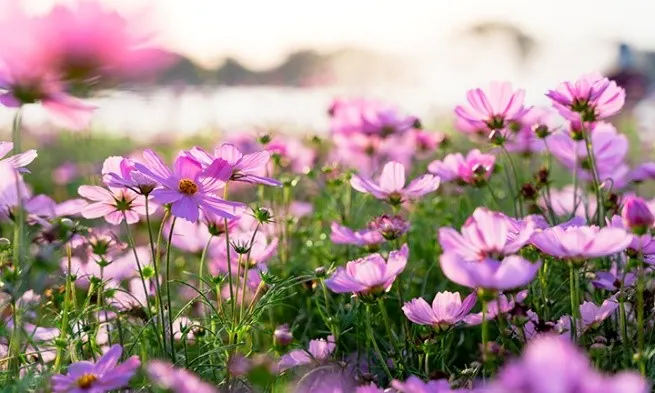Birth Flowers by Month: What is My Birth Flower?
As a new parent, getting the birth flower of your little one can be a memorable and touching gesture that celebrates the new and blossoming life you’ve brought into the world. Imagine a bouquet of newborn-themed flowers like carnations for January, symbolizing love or luck, or daisies for April, symbolizing innocence. So, if you’re wondering “What is my birth flower?” or “What is the flower for my baby’s birthday month?” we’ve got you covered with a list of the birth flowers by month. And as a bonus, we also have the birth flowers for each zodiac sign.
What Are Birth Flowers?
Birth flowers are a lovely tradition, and just like birthstones, each month of the year has a flower associated with it. This flower symbolizes the qualities of the person born in that month.
Having a birth flower for each month is a tradition that started a long time ago and may be rooted in Roman customs. It’s possible that Ancient Romans celebrated births and birthdays with seasonal flowers that were believed to bring luck during the month that they bloomed. The idea evolved over time, and now, each month has specific blossoms that capture the essence of the season and the spirit of those born in it.
Using birth flowers is a sweet, personal way to celebrate your baby’s first birthday (or subsequent birthdays), adding a special touch to gifts and decorations. Flowers allow us to convey emotions and messages through the silent language of floriography, also known as the language of flowers—that’s right—different flowers have had different meanings and symbolism attached to them for thousands of years.
January Birth Flower
What is January’s birth flower? Read on to discover not one but two birth flowers of the month for January.
The Carnation
The January birth flower is the carnation, which is known for its lovely scent and versatility. Carnations are native to the Mediterranean region and come in different colors, each representing a unique meaning. The pink carnation signifies a mother’s eternal love, while the red one symbolizes admiration and deep affection. Then there’s the white carnation which represents pure love and good luck, making it an ideal flower to welcome your little one into the family! Did you know that carnations are not only beautiful but also quite hardy? They can withstand the cold January weather (as long as it’s not below freezing—they typically bloom in the cool of midsummer), which is quite symbolic. Just like these resilient blooms, January babies are believed to embody strength and determination. Additionally, carnations have a soothing, subtle fragrance that can bring a sense of calm and comfort to any room. Just imagine that gentle scent surrounding your little bundle of joy!
The Snowdrop
January actually has two birth flowers! Besides the beloved carnation, January babies have the snowdrop, a delicate white flower. Snowdrops are native to Europe and the Middle East, and they prefer woodland areas. They’re often one of the first spring flowers to bloom, and you may even see them popping up out of the snow. They symbolize hope, beauty, and the arrival of spring. For January parents, the snowdrop celebrates a newborn who brings hope and joy like a snowdrop in winter. Consider the snowdrop to commemorate a January birth—a symbol of pure, hopeful beginnings and the incredible journey of parenthood.
February Birth Flower
What is February’s birth flower? February babies are graced with two gorgeous flowers: violet and primrose.
The Violet
Native to many regions in the Northern Hemisphere, the violet, with its vivid purple hues, symbolizes loyalty, faithfulness, and wisdom. It’s the perfect flower to represent the steadfast love you have for your new baby. Hailing from ancient Greece and featured in Greek mythology, the violet symbolizes deep affection and was historically used in love potions.
The Primrose
Another birth flower for the month of February is the primrose. Primroses are a symbol of youth and new beginnings, making them perfect for a new arrival. They’re native to temperature regions of the Northern Hemisphere and prefer to bloom in early spring. Primroses have also been popular in traditional medicine for centuries. Primroses come in a variety of colors like purple, pink, white, and yellow. They are perfect for planting in your garden or window boxes to show your love and devotion to your child.
March Birth Flower
What is March’s birth flower? With the spring season springing into action, there’s no surprise that the daffodil is this month's birth flower.
The Daffodil
Then comes March, with the daffodil (Narcissus family) standing tall and bright, a sign that spring has arrived. The name Narcissus actually came from a character in Greek mythology. This sun-like bloom, native to Europe, Western Asia, and North Africa brings joy and brightness, just like your spring baby does. The daffodil symbolizes rebirth and new beginnings, which resonate deeply with parenthood.
The Jonquil
Did you know that the daffodil has a close cousin? Meet the jonquil, March’s second birth flower. This bloom, with its sweet fragrance, belongs to the same Narcissus family as the daffodil, and it also has similar symbolism: rebirth and new beginnings. Using jonquils in celebration of an early springtime baby is a beautiful and bright symbol of new life.
April Birth Flower
If you’re wondering “What is April’s birth flower?” April brings fresh blooms and delightful spring fragrances.
The Daisy
The Daisy, a symbol of innocence, purity, and true love, often captures hearts with its simplistic charm. Daisies are native to Europe, but these perky flowers have spread their joy all over the world. They have a fascinating and lesser-known language of their own, too. The word daisy actually means “days eye” in Old English, symbolizing the opening of the flower during the day.
The Sweet Pea
April’s other birth flower is the sweet pea, offering a bouquet of scents as varied and sweet as the babies born in this month. This fragrant bloom is a climbing plant and native to the Aegean Islands. It’s known for bidding farewell or expressing gratitude and appreciation for others. When gifting or using sweet peas, you’re sending a message of pleasure and appreciation, and saying goodbye to winter, welcoming the new joys and challenges of raising your little one. With their ruffled petals and range of pastel hues, sweet peas lend a touch of whimsy to any room—just like your baby will fill your home with joy.
May Birth Flower
What is May’s birth flower? As May arrives with the promise of warmer days and gentle breezes, it brings along two stunning birth flowers—the Lily of the Valley and the Hawthorn.
The Lily of the Valley
The Lily of the Valley, with its delicate and dainty white bells, stands as a symbol of humility and the return of happiness. It is native to Europe and often blooms in late spring, preferring the cool shade. Its sweet, subtle scent can fill any room with a sense of serenity and calm. For your May baby, this flower represents the tender beginnings of life and the heartwarming journey you’ll embark on together.
The Hawthorn
The Hawthorn represents protection and love, with its thorns and sweet-smelling blossoms encouraging us to embrace both the beautiful and the challenging aspects of parenting. It’s native to regions of the Northern Hemisphere and typically grows as shrubs or trees. The hawthorn is also an optimistic symbol of hope.
June Birth Flower
What is June’s birth flower? Celebrate love and say hello to summer with the passionate rose and sweet-scented honeysuckle.
The Rose
Originating from ancient civilizations across the world, roses are a universal symbol of love, honor, faith, and beauty, which can reflect the bond between you and your baby. Did you know that different colored roses also hold different meanings? A classic red rose stands for love, while a pink rose symbolizes gratitude and admiration. You can express your feelings for your June baby through the language of flowers!
The Honeysuckle
The secondary birth flower of June is the sweet-scented Honeysuckle, which symbolizes strong bonds and affection, much like the growing connection between you and your little one. Native to the Northern Hemisphere, the honeysuckle is a resilient vine or shrub. Plus, it’s got a secret superpower—honeysuckle flowers are not only a treat for the eyes, but they can also attract pollinators to your garden!
July Birth Flower
Welcome to the heart of summer, where July babies are celebrated with blooms that are as beautiful and vibrant as they are! So, what is July’s birth flower? Keep reading to find out and let these flowers inspire your celebrations.
The Larkspur
July’s primary birth flower is the beautiful larkspur, symbolizing a carefree lightness and an open heart. It’s native to the Northern Hemisphere. These tall, dramatic spikes of blossoms are often blue or purple but also come in various colors, each with its own meaning: blue for grace, pink for fickleness, white for happiness, and purple for first love. The larkspur is a wonderful symbol of you opening your heart to the pure joy seen in your new baby.
The Water Lily
Now for the serene beauty of July’s secondary birth flower, the Water Lily. This aquatic plant, rooted deep in still waters, is native to temperate and tropical climates around the globe. Symbolic of rebirth, purity, and enlightenment, water lilies are a great representation of bringing new life into the world and the transformation a newborn can bring to our lives. Interestingly, despite their delicate and serene appearance, water lilies are quite resilient—their round leaves support the flowers like parents cradle their newborn, a lovely metaphor for the nurturing love you’ll provide for your July baby.
August Birth Flower
As summer continues to warm our hearts, so do the birth flowers of August. If you’re wondering “What is August’s birth flower?”, keep reading to find out the flower of the month.
The Gladiolus
August’s primary birth flower is the gladiolus, also known as the sword lily due to its striking, tall stalks. They are native to Europe and Africa, preferring lots of sun. The gladiolus comes in an array of bright colors, making them popular in gardens and flower displays. They symbolize strength of character, sincerity, and moral integrity, reflecting the strong foundation you wish to lay for your newborn. Whether in vibrant pinks, purples, or tranquil whites and yellows, each gladiolus carries a message of infallible love.
The Poppy
August’s secondary birth flower is the poppy, native to Europe, Asia, and the Mediterranean. Often found in a vivid red, the poppy is known for representing restful sleep, dreams, and imagination, perfect for a creative child. Some varieties of poppies also come in peaceful white and joyful yellow, symbolizing love and success respectively.
September Birth Flower
What is September’s birth flower? September brings with it the captivating beauty of the Aster and the Morning Glory.
The Aster
As we enter September, the primary birth flower is the aster. The name “aster” actually derives from the Greek word for “star,” shining light on its star-like shape and representing the light that your newborn brings into the world. You could even choose Aster as a name for your September baby, or check out more of our baby names that mean “star.” These daisy-like flowers were used as a symbol of love in Greek mythology, and generally represent love, faith, wisdom, and color—blooming in an array of pretty colors.
Morning Glory
Morning Glory greets each new day with its trumpet-shaped blooms, symbolizing affection and the bonds of love—a fitting metaphor for those precious morning moments with your baby. Interestingly, its flowers bloom each morning, symbolizing the fresh start every sunrise brings. These September blooms, with their soft hues and heartwarming meanings, are perfect for celebrating the new chapter that your September baby represents.
October Birth Flower
What is October’s birth flower? As the leaves begin to change, October introduces us to the warm hues of the Marigold and the tranquil Cosmos.
The Marigold
The robust Marigold, with petals that mirror the sunset, brings with it a bright optimism. Native to North and South America, marigolds are known to hold strong significance in cultures around the world, believed to guide spirits to altars during Dia de los Muertos celebrations. They are also thought to ward off negative energy. Marigolds symbolize creativity, warmth, and energy—perfect for your warm-hearted little artist.
The Cosmos
Cosmos flowers, on the other hand, are like stardust sprinkled across your garden, with their daisy-like wildflower beauty and soft, silky petals. They symbolize balance, inner peace, and serenity, echoing those tranquil moments between you and your baby. With a variety of colors such as pink for love and white for purity, Cosmos flowers are a great way to celebrate the tender affection you feel for your peaceful little child.
November Birth Flower
What is November’s birth flower? As the year begins to wrap up in a cozy blanket, November brings the vibrant Chrysanthemum.
The Chrysanthemum
The Chrysanthemum, with its full, round blooms, is sometimes sweetly known as “mums.” The flowers are a cheerful and colorful bloom for your November baby, representing the brightness and happiness that your new child brings to the world. They originated in China over 2000 years ago, before they were introduced to Japan—becoming their national symbol. In many cultures, Chrysanthemums hold various meanings—from the celebration of life and longevity to a symbol of the sun. They also symbolize friendship, making them an apt choice for a sociable child.
December Birth Flower
And finally, what is December’s birth flower? December wraps the year with the festive greenery of the Holly and the hopeful blooms of the Narcissus (paperwhites).
The Narcissus (Paperwhites)
As the earth lays quiet, paperwhites, a type of narcissus (just like the daffodil) announce the promise of renewal and the start of new beginnings. Native to the Mediterranean, paperwhites are commonly associated with the dawning of good fortune, bringing hope and anticipation for the new year. These delicate and fragrant white flowers are a celebration of the adventures and stories yet to unfold in your newborn’s life.
The Holly
The evergreen Holly is a nod to the enduring nature of love; its prickly leaves represent protection, while the red berries symbolize the warmth and joy found in the heart of families. It even has some small white flowers that blossom in the spring. It’s a reminder of the resilience, optimism, and peace that will surround your December baby through all seasons of life. Take a look at our pretty birth flower chart below for a quick reminder of each flower for each month of the year:
Zodiac Flowers
Now that you’ve discovered your baby’s birth flower, you might also be interested in what flower they are based on their zodiac sign. Here’s a quick overview of birth flowers by date, corresponding to each star sign:
Aries birth flower. The honeysuckle is the flower for babies born from March 21 to April 20
Taurus birth flower. The poppy represents those born between April 21 and May 21
Gemini birth flower. The fragrant lavender is the flower of choice for those born between May 22 and June 21
Cancer birth flower. The white rose represents babies born from June 22 to July 22
Leo birth flower. The bright and tall sunflower is the zodiac flower for those born from July 23 to August 22
Virgo birth flower. The sweet buttercup is the flower of choice for babies born from August 23 to September 23
Libra birth flower. The red rose is the zodiac flower for babies born from September 24 to October 23
Scorpio birth flower. Geraniums are the birth flower for this zodiac sign, for those born between October 24 and November 22
Sagittarius birth flower. The classic carnation is the flower for those born between November 23 and December 21
Capricorn birth flower. The pansy is the flower of choice for Capricorns, born between December 22 and January 20
Aquarius birth flower. For Aquarius babies born between January 21 and February 19, the orchid is the birth flower
Pisces birth flower. The peaceful lily is the zodiac flower of those born from February 20 to March 20.
If you loved these birth and zodiac flowers for your little one, you might also love our list of flower names for girls and flower names for boys.
The Bottom Line
Each birth flower, with its unique color and fragrance, reminds us of the joy and love that comes with every new baby. So why not include these blooms in your next celebration, capturing the essence of each special month and the personality of your little one? And remember, just like every child is unique, every flower has its own story to tell. And if you’re planning a baby shower, you might want to incorporate the baby’s birth flower (if you’re sure of the birth month) into the theme or decoration. You can find more baby shower ideas in our helpful article.









